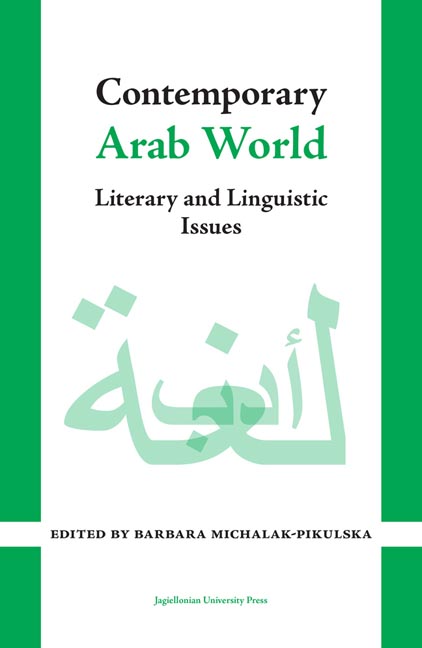Book contents
- Frontmatter
- Contents
- Introduction
- Between past achievements and future challenges Arabic language teaching at the university level – example of the Department of Arabic Studies at the Jagiellonian University in Cracow
- Meanings and functions of genitive constructions in Modern Standard Arabic
- Sultan Qaboos – image of the ruler in panegyrics and elegies by Omani poets
- Microfiction, flash fiction or very short story in modern Arabic literature
- In the maze of discourses – monodrama Bāy bāy Ğīllū (Bye Bye Gillo) by Ṭaha ‘Adnān
- Women in Islamic State propaganda
- Annex
Sultan Qaboos – image of the ruler in panegyrics and elegies by Omani poets
Published online by Cambridge University Press: 14 October 2023
- Frontmatter
- Contents
- Introduction
- Between past achievements and future challenges Arabic language teaching at the university level – example of the Department of Arabic Studies at the Jagiellonian University in Cracow
- Meanings and functions of genitive constructions in Modern Standard Arabic
- Sultan Qaboos – image of the ruler in panegyrics and elegies by Omani poets
- Microfiction, flash fiction or very short story in modern Arabic literature
- In the maze of discourses – monodrama Bāy bāy Ğīllū (Bye Bye Gillo) by Ṭaha ‘Adnān
- Women in Islamic State propaganda
- Annex
Summary
Accession to the throne of His Majesty Sultan Qaboos in 1970 was the real start of a new era in Oman. From the beginning Qaboos underlined that Omani people and their happiness are the most important for him. Qaboos was born on 18th November 1940 in Salalah as the only son of Sultan Sa‘īd bin Taymūr and Sultana Mazūn bint Aḥmad al-Ma‘shanī. He spend his first years of life in Salalah. When he turned sixteen, he went to England, where after a period of private education he joined the Royal Military Academy Sandhurst. After passing out from Sandhurst he spend a year with a British infantry battalion on tour duty in Germany. After returning to his homeland, he studied Islam and Oman's history in Salalah for six years.
After taking power, he encouraged the Omanis scattered around the world to return to their homeland and build a democratic state together. During the 50 years of his reign he built a strong, rich, stable and secure state. His visions with passion and conviction were implemented by the Omani people who have free access to health care, education and culture.
Over the past 50 years Oman has sought to develop friendly relations across the world. Sultan Qaboos offers the hand of friendship on a basis of mutual respect, non-interference in the internal affairs of other states. The Sultanate of Oman is a peace-loving country fortunate to have no problems with any other state. The Sultan himself was keen to promote peace, security and stability in Gulf and beyond.
Sultan Qaboos shares a unique bond with his subjects. From the beginning of his reign he took annual Royal Tours – annual trips around the country in order to get to know the inhabitants personally, their problems, needs and dreams. He learned first-hand on topics that concern the Omanis, and may even affect the future progress and prosperity of the Sultanate.
Qaboos enjoyed enormous authority all his life. He was always generous and made fair decisions. He put the Omani citizens first, and led Oman to flourish. His reign is considered a golden period in the history of the country.
The 1990s were already a full boom of Oman, both economic and socio-cultural. Citizens live in a beautiful and rich country perfectly managed by Sultan Qaboos.
- Type
- Chapter
- Information
- Contemporary Arab WorldLiterary and Linguistic Issues, pp. 69 - 84Publisher: Jagiellonian University PressPrint publication year: 2020

